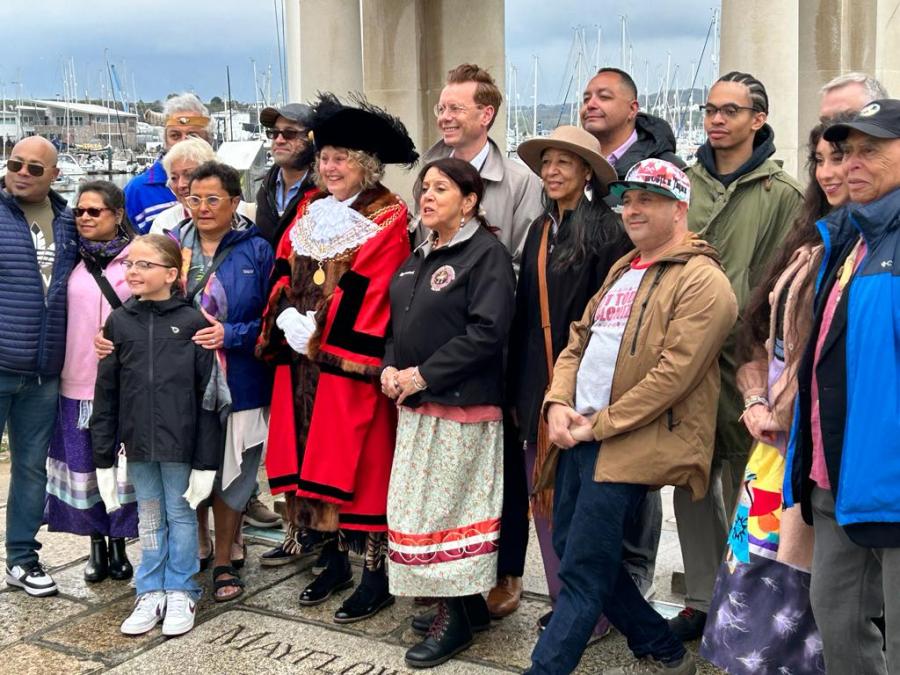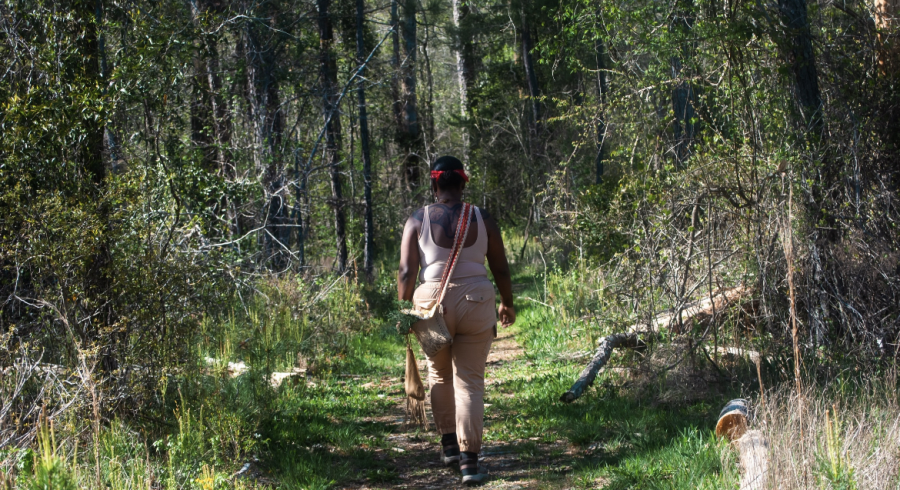The Hopi Reservation in northeastern Arizona encompasses lands that the Hopi people have inhabited for more than a thousand years. Unlike many other tribes, the Hopi people have never been relocated from their ancestral lands to other geographical areas by the United States government. Over the past century, however, the sovereign lands of the Hopi Tribe have been continually reduced through takings by the United States and litigation with the Navajo Tribe. As a result of these actions, access to Hopi ancestral sites and sacred places has become increasingly difficult and, in some instances, dangerous. Shrines are also being desecrated by vandalism or "use" by non-Indians.
The religious practices of the Hopi people are embedded in the landscape that the deity, "Ma'saw," gave to them when they entered into a covenant to earn stewardship of the earth. The ceremonies, pilgrimages and rituals that sustain the Hopi religion are inextricably linked to shrines that were established in ancient times at specific springs, mountain peaks and other sacred areas. These shrines were created in accordance with divine instructions as a permanent testament to the Hopi's covenant with Ma'saw. Each shrine and sacred place contains an irreplaceable life essence that prohibits any relocation or alteration of the shrine.
Hopi religious practice differs from modern Christianity and other western religious, which typically are not dependent on place. The successful practice of Christianity and the practitioner's resultant sense of spiritual contentment can be achieved irrespective of location. The Hopi, on the other hand, must complete certain rituals at specific shrines. The protection of sacred sites and access to them are issues, therefore, that concern the Hopi Tribe. Challenges to Hopi Use of Sacred Sites
The ritual use of Hopi sacred sites is becoming increasingly difficult due to many factors, including development outside of the Hopi Indian Reservation, problems with access of sacred sites on land that the Federal government has given to other Indian tribes, and the appropriation and infringement on shrines by non-Indians.
After the passage of the American Indian Religious Freedom Act (AIRFA) in 1978, the Hopi Tribe, joined by the Navajo Medicine Man Association and the Zuni Tribe, sued the Department of Agriculture in an attempt to block the expansion of a ski development on the San Francisco Peaks near Flagstaff, Arizona, on the Coconino National Forest. This suit charged that the U.S. Forest Service had failed to apply AIRFA, and this infringed on Indian religious rights that the Tribe held were incompatible with expanded recreational use. In this landmark case, the Court decided against the Indians, offering an opinion that AIRFA does not require that access to all publicly owned properties be provided to Indian without consideration for other uses, nor that native traditional religious considerations should always prevail to the exclusion of all else. The expansion of the ski area took place even though the Hopi Tribe considered this to be desecration of a sacred peak.
Today many Forest Service officials are sympathetic with Hopi concerns about sacred sites on the Coconino Forest, but Hopi people are still required to obtain special use permits for collecting the natural resources needed for ritual use. Many Hopi religious practitioners personally view this as an infringement on their rights to freely exercise their religion because the administrative procedures involved in obtaining permits detract from the proper attitudes needed to conduct religious activities. Other challenges to Hopi use of the San Francisco Peaks have come from other groups attempting to appropriate use of mountains for their own religious observances. Several years ago, for instance, a Bahai group applied for a Forest Service permit to conduct religious activities on Mr. Agassiz, one of the Peaks. This concerned the Hopi Tribe because a Two Horn Society (one of the Hopi priesthood organizations) Shrine is located on the peak, and use of the area by the Bahai would result in desecration. The Hopi Tribe considers itself to have a right of first use and maintains that Hopi sacred areas should not be used by other, recently arrived people if that use negatively impacts Hopi values.
A flagrant violation of a Hopi sacred site occurred when two shrines on Woodruff Butte near Holbrook, Arizona, were tragically destroyed in 1990 during the mining of a gravel pit. Although located on private property, the gravel was to be sold for use in the construction of federally funded highways in which a cultural resources inventory was required. Unfortunately, however, the Hopi shrines were not identified as sacred features by the archaeologist who surveyed the area. The Hopi tribal officials discussed their concerns with the contractor who was mining gravel at the site. In response to this humanitarian appeal, the gravel-pit developer deliberately bulldozed the shrines to eliminate the impediment that he thought the shrines posed to the development of the project.
Despite the desecration of the shrines, the area continues to be culturally significant to the Hopi people, as well as to the neighboring Zuni, Navajo and Apache Tribes. in order to halt further destruction of the area, Hopi tribal officials met with the governor of Arizona and the Arizona Department of Transportation (ADOT) to explain their concerns and seek an equitable solution. Further development of the gravel pit for use in ADOT projects has been suspended, but the threat of future mining at Woodruff Butte persists.
Even when sacred sites are identified and afford a certain level of protection, their access and use can still be problematical for the Hopi. This is exemplified in recent incidents at "Ki'iswu" (Cliff Spring), a site the Hopi have used in their religious practices since ancient times. Although Ki'iswu is located on land that a federal court awarded to the Navajo Tribe in Healing v. Jones, the Hopi have an explicit legal right under Public Law 93-531 to enjoy access to, and use of, the spring.
On April 16, 1992, a group of Hopi went to Ki'iswu to dismantle a wall that had been constructed around the spring as part of an Indian Health Service "improvement" project in the 1960s. During the dismantling of the wall, a Katsina priest placed pahos (prayer stick offerings), prayer feathers and piki (a ceremonial food) at the spring to commemorate its opening. As the work progressed, a group of approximately forty Navajos, protesting the Hopi presence at the spring, confronted the Hopi delegation by removing the pahos, prayer feathers and piki and throwing them down at the feet of the Hopi priest. This incident escalated into a violent confrontation between the Hopi and the Navajo, culminating in a physical assault on several of the Hopis.
Later, the Navajos prevented the Hopi from depositing pahos and other offerings at another spring, "Mong'va" (Chief's Spring), by blocking the Hopi vehicles with their trucks. This volatile situation was prevented from becoming more violent by the collaborative efforts of the Navajo Tribal Police, the Hopi Rangers and the Navajo County Sheriff's Department, all of whom worked together to calm the situation and escort the Hopi religious practitioners from the area.
Subsequent attempts to resolve the issues surrounding these incidents were handled at the political level between the Navajo and Hopi Tribes. The chairman of the Navajo Tribe, Peterson Zah, asked the Hopi to inform the local Navajo chapters every time they wanted to visit the spring, a request which the Hopi deemed an unacceptable bureaucratic infringement on the free exercise of their religion. The Hopi believe that they earned a divine right to visit these springs and that Congress, through the passage of P.L. 93-531, recognized this right as a matter of law.
Other Hopi shrines located on the Navajo Indian Reservation have been subjected to vandalism. For instance, the famous Hopi clan marks at Tutuveni near Tuba City, Arizona, have been desecrated by graffiti and spray paint. These clan symbols were incised on the rocks during ritual pilgrimages to the Hopi Salt Mine in the Grand Canyon. Attempts to remove the spray paint have not been entirely successful [see photograph]. Such vandalism saddens Hopi people.
The Hopis also face challenges to the sanctity of shrines and cultural sites on their own reservation. "New Agers" have begun to leave crystals and other "offerings" at Hopi shrines. While these New Agers are apparently sincere, they don't realize that the appropriation of Hopi shrines desecrates them and mocks the Hopi religion. Petroglyph sites such as the so-called "Prophecy Rock" on Third Mesa, named by New Agers and other "worshipers," have also been appropriated by non-Indians who have begun to leave "offerings" there. These "offerings" are offensive to the Hopi people. Historic preservation as a Strategy to Protect Sacred Sites
As these examples demonstrate, the Hopi people face continuing problems in their efforts to maintain the integrity of sacred places. Because litigation based on AIRFA has not been successful, the Hopi Tribe's Cultural Preservation Office has turned to the historic preservation compliance process as a strategy to protect sacred sites. Under the National Historic Preservation Act, shrines are considered to be traditional cultural properties, that is, historic sites important in the maintenance and transmission of Hopi culture. As such, these sites need to be identified during project planning and, if deemed significant, measures to protect them must be developed. Unlike archaeological sites, however, where adverse impact to historical values can be "mitigated" through scientific studies, there is no way to "mitigate" adverse impacts to Hopi sacred sites because they are unique and irreplaceable resources. The only "mitigation" is complete avoidance.
Archaeologists sometimes find it difficult to recognize Hopi shrines because the simple stone constructions that often mark them may resemble mere rock piles or other natural features. In addition, may shrines are located atop or within ancestral archaeological sites that preoccupy the attention of archaeologists and are, therefore, ignored. Consequently, the policy of the Hopi Tribe is to use Hopi Tribal members as consultants in investigations to identify Hopi traditional cultural properties. The incident at Woodruff Butte taught the Hopi Tribe the importance of becoming actively involved in the identification of shrines and other sacred places in the early stages of historic preservation research and planning. If Hopi sacred places are not identified, their significance cannot be assessed; if the shrines are afforded no protection, incidents similar to Woodruff Butte are bound to continue.
The identification of shrines and other sacred sites for purposes of historic preservation planning, however, puts information into the public domain, and this adversely impacts the confidentiality of these sites. It is a difficult choice between releasing information to protect sacred sites from development and keeping their locations a secret to protect them from exposure to non-Indians.
In recent years, the Hopi Tribe has participated in a wide range of projects to identify Hopi shrines and other traditional cultural properties in areas subject to development or impact. Sacred Hopi trails and other cultural sites that will be impacted by a proposed coal mine near the Zuni Salt Lake in new Mexico were studied on a project sponsored by the Salt River project, a utility company in Phoenix, Arizona. Hopi shrines and ancestral sites in the Grand Canyon have been studied in cooperation with the National Park Service for the Glen Canyon Environmental Studies program, sponsored by the Bureau of Reclamation [see photograph]. The Hopis who have been consulted on these projects have assessed impacts to traditional cultural properties and developed recommendations on how to best protect these sites. The participation of the Hopi Tribe in these projects does not mean that the Hopi people endorse these projects; it only means that the Hopi Tribe is working to protect its sacred sites and cultural interests.
While these projects demonstrate that historic preservation can be used effectively to protect Hopi sacred sites, the strategy is not a perfect solution to the problem. Using the National Historic Preservation Act to protect sacred sites reduces these precious cultural resources to historic properties and does not consider their true spiritual significance. Decisions about the significance of traditional cultural properties are made by federal agencies and State Historic Preservation officers, using a value system that differs substantially from that held by the Hopi. This sometimes results in historical values taking precedence over spiritual values in a way that in incomprehensible to Hopi religious leaders.
Furthermore, publication of information about sacred sites in cultural resource management reports and in associated academic publications presents a vexing paradox that the Hopi Tribe is only now beginning to confront. Information about sacred sites needs to be divulged in order to protect them but the very process of divulging this information is also an adverse impact to them. Indiscriminate writing about sacred sites exposes them to desecration by new Agers and vandals. Hopefully, as federal, state and private land-managers continue in dialogue with the Hopi people about sacred sites, there will be increased recognition of the importance of these cultural resources and an effort to develop more sensitive ways to protect them.
Hopi shrines and sacred sites are essential in the practice of the Hopi religion. With out them, the Hopi people cannot fulfill their religious obligation to serve as stewards of the land. For this reason, the Hopi Tribe will continue to do everything it can to protect sacred sites, including the development of new strategies that can be applied in addition to historic preservation. Hopi cultural preservation is predicated on the continued use of the sacred areas that are the legacy of Hopi ancestors. Article copyright Cultural Survival, Inc.



